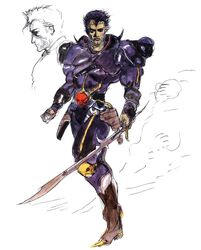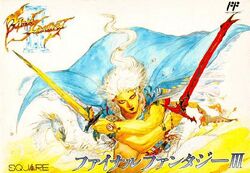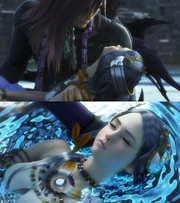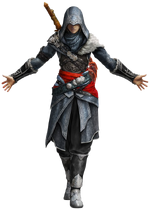Template:Sideicon
This is a list of allusions from Final Fantasy XIII-2.
Final Fantasy series
- Mog is called "Piggy Kitty" by Noel when a Breshan researcher asks him about it. Moogles first appeared in Final Fantasy III where they said "nyaa", Japanese onomatopoeia for "meow", which was soon replaced with "kupo". Moogles in some games resemble a pig; hence the "name".
- Chocolina's nickname, Choco-boco-lina, refers to Choco and Boco, two recurring names for chocobos, the series' recurring mascot.
Final Fantasy
- When playing Slots in Serendipity, the sound effect for hitting one of the jackpots is the "Getting an Important Item" theme, first heard in the original Final Fantasy.
Final Fantasy II
- Caius's armor and accessories are based on Yoshitaka Amano's artwork
 of Leon.
of Leon. - In the quiz Brain Blast, the answer to one of the questions is "Wild Rose". This password was used by the rebels of Fynn. Another incorrect answer to the same question is "Ekmet Teloess", which was a key term that was used to open a door.
Final Fantasy III
- The colors of Noel's swords, red and yellow, are based on those of the original protagonist of Final Fantasy III from Yoshitaka Amano's artwork
 .[1]
.[1] - One of the possible answers for a Brain Blast question—"What was the name of the device used by Sanctum's elite soldiers that allowed one to control gravity?"—"Noah's Lute".
Final Fantasy V
- Similarly to Galuf, Noel arrived on a meteor. Both suffer from amnesia.
- The maximum HP of both Tonberry and Don Tonberry, 393,939, refers to the maximum HP, 39,393, of the Tonberry from Final Fantasy V where it first appeared.
- Gogmagog and Aloeidai's backstory is based on Omega and Shinryu where in both games they are said to be each others' enemies that travel the Void.
- A downloadable monster, Omega, is based on his Final Fantasy V appearance.[2]
- One of possible answers for a Brain Blast question—"What was the name of the device used by Sanctum's elite soldiers that allowed one to control gravity?"—"Galuf's Bangle".
Final Fantasy VI
- In the casino Serendipity, the player can exchange their winnings for an item called "Setzer's Dice". Its description says Setzer's "consummate skill once drove Serendipity to the brink of ruin". Setzer Gabbiani is a Gambler in Final Fantasy VI and the first gambler to appear in the series.
- The answer to one of the questions in Confounding Quiz—"What legendary creature was found in a block of ice on Gran Pulse?"—is "Valigarmanda". In Final Fantasy VI, Valigarmanda was found frozen in the Narshe Mines.
- Terra Branford is mentioned in the Confounding Quiz, and is said to be an actress. She is said to be dating Jeff Roni, a double reference to Edgar Roni Figaro; Jeff refers to Geoff, the Japanese version of his alias Gerad.
- Downloadable monsters, Ultros and Typhon, are based on their Final Fantasy VI appearances. During their fight Ultros flirts with Serah, states his hatred for muscle-heads, and introduces Typhon in the same fashion and similar choice of words as in his final fight with Terra and company in Final Fantasy VI.
- Gilgamesh found Masamune in a poisoned river in a kingdom called Doma. Despite many years, it doesn't age.[3]
- When the Flowering Cactuar is caught, its name changes to "Cactrot", alluding to the initial translation of "cactuar".
Final Fantasy VII

Caius laying Yeul's body into water.
- Caius putting Yeul to rest in the sea by Valhalla mirrors the scene where Cloud Strife rests Aerith Gainsborough in the lake of the Forgotten City.
- In the quiz Brain Blast one of the answers to a question is "Honee Bee Inn". This refers to the Honey Bee Inn location in Final Fantasy VII.
- Another question in the Brain Blast quiz refers to Cloud Strife's Chocobo race at the Gold Saucer to free his companions from the Corel Prison.
- In the quiz Brain Blast, one of the answers is "Patisserie Red Thirteen", referring to the character Red XIII.
- When collecting a paradox weapon in Academia 4XX AF, the desk clerk jokingly tells Serah and Noel they have to choose between a large box and a small box. This is likely an allusion to obtaining Aeris's level 4 limit break, Great Gospel, which is in the smaller of two sealed boxes.
- The Sister Ray is listed as one of the possible answers in Brain Blast.
- In the Brain Blast quiz, one of the answers are lyrics of the song playing during the battle with Safer∙Sephiroth, "One-Winged Angel".
- Serendipity bears an intentional resemblance to the Gold Saucer, including the camera view being set at a distance rather than following the characters closely.
Crisis Core -Final Fantasy VII-
- In the quiz Brain Blast one of the answers to the question "What was the name of the mission to drive out the inhabitants of Bodhum when a Pulse fal'Cie was discovered?" is "Project Genesis" and "Project: Fill the world with flowers", and in other question given by Captain Cryptic, LOVELESS is one answer too. Project G in Crisis Core stands for "Project Genesis", a branch of the Jenova Project. LOVELESS is the epic Genesis Rhapsodos is obsessed with.
- Hyperion (Teioh) is referred to being the fastest chocobo in the chocobo races. In Final Fantasy VII the player can race Teioh, whose Japanese name, Hyperion, was alluded to in Crisis Core -Final Fantasy VII-.
Final Fantasy VIII
- The answer to one of the questions in Confounding Quiz—"Which celebrated movie introduced the gunblade, a now-popular toy among kids?"—is "The Sorceress's Knight". This refers to Final Fantasy VIII where Laguna Loire stars in said movie as the knight Zefer, wielding a gunblade.
- Watts and Balamb Garden are referred to in incorrect answers to Brain Blast questions.
- "Project: Fill the world with flowers" is an answer to a Brain Blast quiz. This is one of the possible dialogue options the player can choose when interrogated in the D-District Prison in Final Fantasy VIII. Specifically, if the player has Squall lie in regards to the "true mission" of SeeD, he states that they plan to fill the world with flowers to make people docile, then invade.
- The abilities Bargain Hunter and Haggler were introduced in Final Fantasy VIII under the names Haggle and Sell-High, respectively.
- PuPu may rarely drop an Elixir: this refers to PuPu in Final Fantasy VIII requesting Elixirs from the party. This may be seen as a joke of PuPu having too many Elixirs.
- The seeress-guardian relation can be compared to sorceress-sorceress knight relation in that in both gifted women with special powers have a protector.
Final Fantasy IX
- Several of Noel's dual blades are named after Zidane's thief swords, mainly: Rune Tooth, Sargatanas, and The Tower.
- Stiltzkin's Journal is a set of accessories named after the moogle Stiltzkin.
- In the quiz Brain Blast, Tantalus is mentioned in several questions, which involve some kind of love play. Tantalus is a popular theater troupe from Lindblum in Final Fantasy IX.
- In the quiz Brain Blast, one of the answers is "Stiltzkin's Bakery".
- Gilgamesh found Excalibur in a hidden room in kingdom of Alexandria. It dazzles with rainbow's colors.[3]
Final Fantasy X
- The idea of an Eidolon having a dark counterpart originates from the International Version of Final Fantasy X where the party can fight Dark Aeons as a challenge.
- The term "Guardian" originates from Final Fantasy X, where guardians were charged with summoners' protection. In Final Fantasy XIII-2, a Guardian is charged with seeress's protection.
- Serah and Noel have a downloadable outfit paying homage to Final Fantasy X; Summoner's Garb for Serah is based on Yuna's outfit, while Battle Attire for Noel has one leg shorter than the other leg similar to Tidus's outfit.
- The answer to one of the questions in Confounding Quiz—"What is the name of the exciting underwater sport that requires a ball?"—is "blitzball".
- O'aka is offered as one of the possible answers in a question from Captain Cryptic regarding a shop offering monster materials.
- Zanarkand is an answer to one of the Captain Cryptic questions.
- Gilgamesh found Muramasa in the abandoned ruins of Zanarkand. It is said that spirits of those who died from Sin rest within the blade.[3]
- One of possible answers for a Brain Blast question—"What was the name of the device used by Sanctum's elite soldiers that allowed one to control gravity?"—"Cloudy Mirror". Cloudy Mirror is an object in Final Fantasy X needed to obtain the party's Celestial Weapons.
Final Fantasy X-2
- The concept of enemies fighting alongside party members is taken from the International version of Final Fantasy X-2, where monsters can be recruited and used in battle with its Creature Creator system.
- One of the incorrect answers to a question in Captain Cryptic's Confounding Quiz is "Magical Dances, I & II", which were key items used to learn special abilities for the Songstress dressphere.
Final Fantasy XI
- The music that plays on acquiring a Fragment Skill from the Mystic in Serendipity is a shortened fanfare of the "Chocobo Theme", which was first heard as the <call4> sound effect in Final Fantasy XI.
Final Fantasy XII
- One of the Great Mog Wisdom fragments is called "Teatime Mont Blanc in reference to the moogle by the name of Montblanc.
- The name Undying is also used as the name of the final boss in Final Fantasy XII.
- The party leader icon resembles the one from Final Fantasy XII.
Final Fantasy XIII
- Yeul is named after the author of the fourth Analect from Final Fantasy XIII, "the seeress Paddra Nsu-Yeul".
- Twilight Odin, a corrupt remnant of Odin, is found and fought at the Vile Peaks as a reference to the original encounter between Lightning and Odin.
- The final dungeon, Academia 500 AF, changes its configuration similarly to the Tesseracts of the Orphan's Cradle.
- Full ATB skills are unlocked when reaching Stage 11 of the Crystarium. In Final Fantasy XIII, they are unlocked in Chapter 11.
- New Bodhum looks similar to the playable area of Bodhum. Both share a large beach with a pier, a NORA bar, and a similarly styled "wall" that in Final Fantasy XIII prevents further exploration of the town.
Final Fantasy Type-0
- Items found in Augusta Tower in the Japanese version of the game has the suffix "Type-XNumber added after the dash.", similarly to the title of another Fabula Nova Crystallis: Final Fantasy project.
Dissidia Final Fantasy
- Gilgamesh found Zantetsuken, also known as Chaos Nail, during his Dissidia 012 Final Fantasy appearance. It is said that it is Chaos's nail, which is rare, and is theorized to be made of crystal. The power of death is said to be endowed within this blade. This could be an allusion to him being the only character to canonically defeat Feral Chaos in Cid's nightmare, as he had no link to the primary events of Dissidia outside of fighting Bartz and meeting Squall and company. [3]
Fabula Nova Crystallis: Final Fantasy
As part of the Fabula Nova Crystallis: Final Fantasy subseries of games, Final Fantasy XIII-2 uses elements from the official mythos; whereas Final Fantasy XIII mainly indirectly alluded to the concepts from the mythos, Final Fantasy XIII-2 implements them more directly.
- The fragments Etro's Sorrow, Pulse's Resolution, Lindzei's Desire, Mwynn's Tenderness and Bhunivelze's Sleep allude to the official mythos where Etro suffered abandonment, Pulse was determined to find the gate to the afterlife, Lindzei wanted to protect the world, Mwynn was kind and compassionate, and Bhunivelze fell into a deep crystal sleep to be awaken when the Door of Souls would be found.
- Chaos, the malevolent substance that is also the building block for human souls, was not mentioned in Final Fantasy XIII, but plays a crucial role in Final Fantasy XIII-2. The idea alludes to the official mythos where chaos was shown as the substance threatening world balance.
- The concept of reincarnation is introduced in the form of Yeul and Valhalla. In the official mythos all souls part of a soul cycle are eventually reincarnated. In Final Fantasy XIII-2 souls pass on through Valhalla to the unseen realm where they turn into the chaos that eventually becomes new souls for the mortal realm, but Yeul was unable to fade into chaos and thus Etro took pity on her and always sent her back to the mortal realm to be reborn as the same person.
- In the official mythos goddess Etro crafts people's hearts by placing a shard of chaos inside every newborn. In Final Fantasy XIII-2 Caius has the "Heart of Chaos", said to be Etro's own heart and given to him by her.
- Hope named the New Cocoon "Bhunivelze" after the deity who created Pulse, Lindzei and Etro in the official mythos.
Other Square Enix projects
Chrono Cross
- "Serge" is one of possible names for Paradigm Pack monsters.
Kingdom Hearts series
- When Lightning beckons to Serah in the dream of New Bodhum, she emulates Riku's iconic scene in the original Kingdom Hearts where he reaches for Sora to follow him. Riku is engulfed in darkness. After having her proposal refused Lightning is similarly engulfed in chaos.
- The concept of an evil eye in Caius's sword's rain-guard is similar to the concept of the eye of darkness adorning the Darkness-associated Keyblades.
- The bowsword Starseeker shares its name with the Keyblade Star Seeker.
Allusions to the numbers thirteen and two
Being the sequel to the thirteenth installment of the series, Final Fantasy XIII-2 makes some references to the number itself. It occasionally even makes references to both the numbers 13 and 2 together. Although many of these are not necessarily deliberate allusions to those numbers (whether they are or not is speculative), they are nonetheless present.
- In all three of the game's fully rendered cinematics, there are thirteen tolls of a bell. In the opening cinematic and the mid-story cinematic there are thirteen tolls while Lightning narrates; in the closing cinematic there are thirteen tolls of a bell before the credits roll.
- In Academia 4XX AF, there is an ark floating in the sky called the Thirteenth Ark.
- In the paradox ending, "Transcript: The Future is Hope", Snow mentions that he must visit thirteen different eras to resolve paradoxes by collecting thirteen crystals.
- The DLC "monsters" Lightning, Amodar, Nabaat, Ultros, Typhon, Gilgamesh, and PuPu all have a maximum level capacity of thirteen.
- The mechanics of Lightning's special attack Legion of One are identical to those of the original Army of One, but with one additional strike as the finisher that brings the overall hit count up to thirteen.
- There are various instances in the game to suggest there are twenty-six hours in a day, or thirteen hours before noon and thirteen hours after noon.
- At the beginning of the opening cinematic, a large clock is seen in Valhalla, and the hands point to the number thirteen.
- In the Temporal Rift puzzle The Hands of Time, there can be a maximum of thirteen positions on the clock.
- In the Serendipity card game Chronobind, there are thirteen hours on the clock.
- There are thirteen categories for the fragment entries.
- If one counts the Paradox Scope battles, the Chaos Bahamut battles, and the DLC, Caius is fought a total of thirteen times.
- The Brain Blast quiz says that the skyscraper's observation deck in Academia was built on a floor 132nd based on the incident of 100 AF, alluding to the numbers of the game: "13" and "2".
- In Final Fantasy XIII, the threshold for a five-star rating for a normal battle was 13,000. In Final Fantasy XIII-2, the score is 15,000: 13,000 + 2,000.
- Including "Paradox", there are thirteen versions of "Paradox" theme in the game.
- There are thirteen artefacts.
- Augusta Tower was built by the Academy in 13 AF, and it was also in this year that the Proto-Fal'cie project which created Adam began.
Games

Ezio Auditore's outfit for Noel.
- Ezio Auditore da Firenze's outfit from Assassin's Creed: Revelations is available for Noel Kreiss as a downloadable content.
- Commander Shepard's N7 Armor from Mass Effect 3 also is available for both Serah and Noel as downloadable content.
- Amodar's Iron Bear Claw attack resembles the Shun Goku Satsu, or Raging Demon, the signature super combo of Akuma (Gouki) in the Street Fighter fighting game series. Using the Feral Link in battle also uses the same command input as the Shun Goku Satsu.
Folklore
- Gogmagog is a reference to Gogmagog, a giant from British folklore.
- The expression to "spirit away" means to remove without anyone's noticing. Kamikakushi (神隠し, hidden by god?) means "spirited away". Kamikakushi is used to refer to the mysterious disappearance or death of a person that happens when an angered god takes a person away. In pre-modern Japan children would often disappear in this way and be rediscovered several days later in a shrine or temple, consistently telling a story of being swept away by a god. Lightning's disappearance to an otherworldly realm governed by the goddess may hearken to this folk designation.
Greek mythology
- Atlas is a reference to Atlas, a Titan who rebelled against the gods and was punished to hold the sky on the western edge of the world.
Norse mythology
- Lightning's story is set in Valhalla, "a realm beyond time" where the temple of the goddess is placed, in which she fights alongside her Eidolon, Odin, repelling attacks from Caius. In Norse mythology, Valhalla is the hall of the honored dead who will fight for Odin at Ragnarök.
- Lightning in her new attire resembles a valkyrie, one of the female warriors who bore the valorous dead to Valhalla. Caius calls her the "warrior goddess", another title for a valkyrie.
- Furthermore, three valkyrie names are referenced through fragments in the Yaschas Massif 110 AF: Gerhilde's Blossom, Waltraute's Flower, and Ortlinde's Bloom.
- The Arbiter of Time Valfodr is named after the Norse god Baldr. Valfodr is also an alternate name for the Norse god Odin, which translates as, "father of the slain".
- In the Brain Blast quiz, a forest by the name of "Bifrost Forest" is mentioned: Bifröst is burning rainbow bridge that reaches between Midgard and Asgard, the realm of the gods.
Sumerian mythology
- Gilgamesh was a mythical hero of the ancient Sumerians. He was king of the city of Uruk, and had a series of adventures with his great friend, the wild man Enkidu.
Japanese mythology
- Serah's bowsword and Noel's dual swords are called in the English release "Odinbolt" and "Odinblade" respectively, but in the Japanese release they are known as "Takemikazuchi" and "Futsunomitama". Futsunomitama is a sword said to have been wielded by Takemikazuchi, a thunder god, in his campaign to bring order to Ashihara-no-Nakatsukuni in ancient Japan. The English descriptions for both weapons allude to this connection, as Odinbolt's description says that it is "named after the wargod of storms" (somewhat coincidentally, in Final Fantasy XIII trilogy Odin is an Eidolon associated with the element of lightning) and Odinblade's description states it is a weapon that "crackles with almost divine power".
- When the Academia receptionist tells Serah and Noel to choose between Odinbolt and Odinblade, she jokes about giving them an option to choose a large box or a small box. This is a reference to the tale of Urashima Tarō.
Roman and Byzantine empires
- Most of the Undying are named after enemies of the Roman Empire, except for Wladislaus, which is named after a Polish king, and Raspatil, though its Japanese name is Attila.
Religious tradition
- One of the questions in Brain Blast mentions "sabbath" as an event where people gather to watch monsters dance and frolic. In many religions, sabbath is a weekly day of rest.
Christianity
- The seven chocobo chicks in Serendipity (Haughty, Sloth, Wrath, Neid, Luxuria, and Greed) are named after the seven deadly sins and act on their namesakes to an extent.
- There is a sequence involving a guy named Brant who enjoys puns. One of these puns is "Need an ark? I Noah guy!", a reference to the ark build by Noah on which two of each type of animal the world was placed to escape a cataclysmic flood.
- Noel's and Yeul's names refer to Christmas, though the latter is spelled "Yule".
Super Mario
- The red-capped, white-spotted Delicious Mushroom adornment is an allusion to the red-capped, white-spotted Super Mushrooms from the Super Mario series of video games where contact with a Super Mushroom causes a player's character to grow larger. The description for the Delicious Mushroom is "A mushroom that looks like it might help you grow bigger..."
Pokémon
- An answer to a Brain Blast! question is "Ochu, I choose you!". "I choose you" is a recurring phrase in Pokémon media, and is often associated with the character Pikachu, whose name ends with same last three letters.
Terminator 2: Judgment Day
- An answer to a Brain Blast! question is "Hasta la vista, kupo!", paraphrased from Arnold Schwarzenegger's famous line from Terminator 2: Judgment Day.
Star Wars
- Three of the answers to a particular Brain Blast! question refer to Star Wars.
- One of the answers is "Do or do not, there is no try," referential of a line of Yoda's in Episode V: The Empire Strikes Back.
- Another answer is "May the light be with us!" a spin on the phrase "May the Force be with you" from the series. The correct answer to the question is "You're from the rebel army!," a reference to the Rebel Alliance from the original Star Wars trilogy.
Other Media
- One of the possible answers in the Brain Blast! question is "Desperate Housewives of Eden"—referencing both the Desperate Housewives series and The Real Housewives of the Orange County series.
- One of the possible answers in the Brain Blast! question is "Murder, Bodhum Wrote"—referencing the Murder, She Wrote series.
- In a "Great Mog Wisdom" fragment entry it is revealed that a vidshow called The Katzroy Files was made using Sazh Katzroy as inspiration for the lead character. The name may be an allusion to the show The Rockford Files.
- The Miniflan Fragment mentions a group of five miniflan with the following colors: blue, black, pink, yellow, and red. The colors correspond to colors of the outfits of a popular TV series, Power Rangers.
- The correct answer to a Brain Blast! question about chocobo racing is "A prisoner won the race and he and his group were pardoned", This is a reference to the film Death Race, where prisoners are offered the choice to participate in the titular race to earn their freedom.
Other
- The Elixir energy drink is referred to in one of the possible questions in Captain Cryptic's Confounding Quiz: "What was the design found on elixir cans that portrayed the incredible journey of the legendary l'Cie?" The correct answer is: "A white background with pictures of the l'Cie".
- There is a Brain Blast quiz asking about who scored the most points in Cocoon's Premium League and one of the choices is "Elwin van der Sar", most likely a reference to Edwin van der Sar, the former Manchester United legend who played in the English Premier League.
- A possible name for a recruitable monster is "Illuminati".
